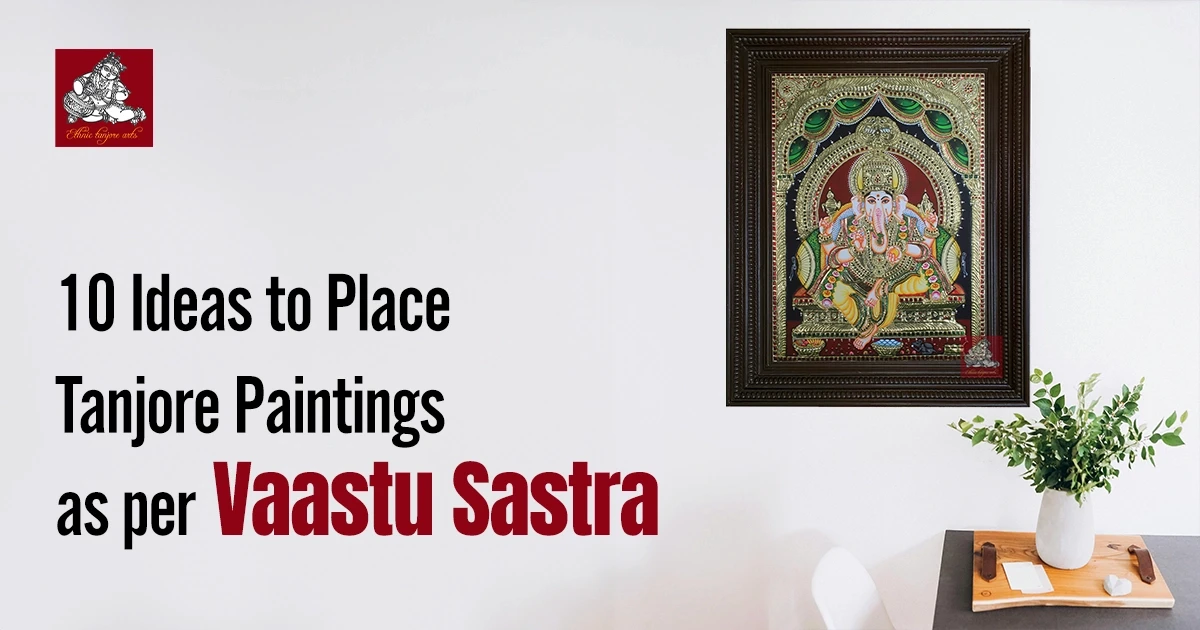10 Ideas to Place Tanjore Paintings as per Vaastu Sastra
Feb 7, 2025
Tanjore paintings are beautiful Indian paintings known for their gold foil, bright colors, and images of gods and goddesses. These God paintings are not just art—they also bring positive energy to your home! According to Vaastu Shastra (an ancient Indian science of architecture), placing Tanjore arts in the right spots can attract peace, luck, and success.
Let’s explore the 10 best places to keep these best Tanjore paintings to make your home happy and harmonious.
1. Pooja Room – The Ideal Spot for Divine Blessings
Type of Deity : The ideal choices for Tanjore paintings in the Pooja room include deities such as Lord Krishna, Lord Ganesha, Goddess Lakshmi, and Goddess Saraswathi.
Vaastu Shastra: The Pooja room should ideally be located in the northeast, north, or east direction of the home.
Symbolism of Deities:
Lord Ganesha: Symbolizes the removal of obstacles and is often worshipped at the beginning of any new venture.
Goddess Lakshmi: Represents wealth, prosperity, and abundance.
Goddess Saraswathi: Embodies knowledge and wisdom.
Vaastu Tips for Pooja Room Placement:
Create a serene atmosphere by using light colors which symbolize purity and positivity.
Incorporate soft lighting to illuminate the Tanjore paintings.
Use decorative elements like incense holders or candles around the paintings.
2. Living Room – Attract Peace and Harmony
Type of Deity : Include god paintings of Lord Ganesha, Radha-Krishna, or Goddess Lakshmi.
Vaastu Shastra: The best placement for these paintings is on the east or north walls of the living room. This positioning allows for the maximum flow of positive energy and light.
Symbolism of Deities:
Lord Ganesha: Represents the removal of obstacles and brings good fortune.
Radha-Krishna: Symbolizes love and unity, fostering a sense of togetherness.
Goddess Lakshmi: Embodies wealth and prosperity.
Vaastu Tips for Living Room Placement:
Ensure the painting is well-lit and placed at eye level for maximum impact.
In spacious living rooms, consider displaying a large Tanjore painting as a statement piece.
Use smaller Tanjore paintings on coffee tables or side tables to add touches of regality and elegance.
3. Entrance or Foyer – Invite Good Luck
Type of Deity : The ideal choice for the entrance or foyer is a Tanjore painting of Lord Ganesha.
Vaastu Shastra: It is recommended to place the painting of Lord Ganesha facing the entrance.
Symbolism of Deities:
Lord Ganesha: Ganesha, known for his ability to remove obstacles, symbolizes new beginnings and success in Tanjore paintings. It is often depicted with elements like sweet dumplings and a broken tusk.
Vaastu Tips for Entrance Placement:
Opt for a medium or large-sized Lord Ganesha Tanjore Painting to create a grand welcome for your guests.
Hang the painting facing inward to welcome positivity into your home.
Consider using spotlights or decorative wall sconces to highlight its beauty.
4. Dining Area – Encourage Positivity in Relationships
Type of Deity: The ideal choice for the entrance or foyer is a Tanjore painting of Sri Annapoorani Devi and Goddess Lakshmi.
Vaastu Shastra: The best placement for these paintings is on the south or west wall of the dining area. This helps create a warm and inviting atmosphere, encouraging harmonious interactions during meals.
Highlight the Symbolism of Deities:
Goddess Annapoorani: Represents nutrients and energy, also ideal for healthy relationships through shared meals.
Goddess Lakshmi: Sym bolizes wealth and prosperity, enhancing the dining experience.
Vaastu Tips for Dining Area Placement:
Use Tanjore arts as a focal point on one wall complemented by a beautiful dining table setting.
Ensure that the God paintings are well-lit with soft lighting or spotlights.
Keep the dining area clean and clutter-free to maintain positive energy.
5. Bedroom – Promote Calmness and Serenity
Type of Deity: Ideal choices include Tanjore paintings of Goddess Saraswathi or serene representations of Lord Buddha.
Vaastu Shastra: It is recommended to place these paintings on the south or west wall of the bedroom.
Goddess Saraswathi: Symbolizes knowledge, creativity, and purity, providing mental clarity and inspiration, making it an ideal choice for students or creatives.
Lord Buddha: Symbolizes peace and enlightenment. A painting of Buddha can foster a sense of calmness and mindfulness.
Vaastu Tips for Bedroom Placement:
Choose soft, calming colors for the walls that complement the Tanjore painting.
Use soft lighting to highlight the painting without overwhelming brightness.
Place the artwork at eye level or slightly above for a calming effect.
Keep the bedroom clean and clutter-free to maintain a peaceful vibe.
6. Study Room – Enhance Focus and Wisdom
Type of Deity Tanjore Painting: Ideal choices include Tanjore paintings of Goddess Saraswathi and Lord Ganesha.
Vaastu Shastra: It is recommended to place these paintings on the east or north wall of the study room.
Goddess Saraswathi: Symbolizes knowledge, music, art, and wisdom.
Lord Ganesha: His depiction encourages focus and determination.
Vaastu Tips for Study Room Placement:
Avoid placing the painting behind your chair—hang it in front or to the side.
Keep the study area organized to maintain positive energy.
Incorporate a well-organized desk setup with bookshelves that complement the Tanjore paintings.
Add elements like motivational quotes framed alongside the paintings of a small indoor plant.
7. Office or Workspace – Attract Success
Type of Deity: For an office or workspace, ideal choices include Tanjore paintings of Lord Ganesha and Goddess Lakshmi.
Vaastu Shastra: According to Vaastu Shastra, it is recommended to place these paintings on the north or east wall of the office.
Symbolism of Deities:
Lord Ganesha: Known as the remover of obstacles. Lord Ganesh's presence encourages focus, determination, and success in projects and tasks.
Goddess Lakshmi: Symbolizes wealth and prosperity, making her depiction for attracting financial stability and abundance in business.
Vaastu Tips for Office Placement:
Avoid placing Tanjore paintings behind your chair, as it may create a sense of pressure. Instead, hang them on the wall in front of you or to your side.
Place motivational quotes alongside the painting to create an inspiring environment.
Keep the area around the painting organized and clutter-free to maintain a clear mind and boost productivity.
8. Hallway or Passage – Maintain Positive Energy Flow
Type of Deity: Ideal choices for hallways or passages include Tanjore paintings of Lord Murugan, Lord Vishnu or Lord Ganesha.
Vaastu Shastra: It is recommended to place these paintings along the north or east walls of the hallway. This positioning helps maintain a continuous flow of positive energy.
Symbolism of Deities:
Lord Murugan: The God of War, is thought to promote energy and provide protection for the home.
Goddess Durga: Symbolizes power, protection, and unbeatable spirit, ensuring the house is protected.
Lord Ganesha: Acts as a barrier remover, guarding against negative energies and fostering a sense of safety and positivity.
Vaastu Tips for Hallway Placement:
Hang the paintings at eye level so they are easily visible and appreciated.
Avoid overcrowding the hallway with too many artworks. One or two Tanjore arts are enough to maintain a clean and positive energy flow.
Ensure the paintings are well-lit, either with natural light or soft artificial lighting, to enhance their golden details.
9. Meditation or Yoga Room – Deepen Spiritual Connection
Type of Deity : Ideal choices include Tanjore paintings of Lord Buddha, Sai Baba and Goddess Saraswathi.
Vaastu Shastra: It is recommended to place these paintings on the east or north wall of the meditation or yoga room.
Symbolism of Deities:
Lord Buddha: Represents enlightenment and inner peace. His presence in the room promotes tranquility and mindfulness.
Goddess Saraswathi: Symbolizes knowledge, wisdom, and creativity. Her depiction inspires clarity of thought and enhances spiritual growth.
Vaastu Tips for Meditation Room Placement:
Place the painting at eye level or slightly above, so it’s easy to focus on during meditation.
Avoid cluttering the room with too many decorations. Let the Tanjore painting be the centerpiece.
Incorporate indoor plants or natural wood accents to create a calming atmosphere.
10. Cash Locker or Wealth Area – Invite Financial Stability
Type of Deity: Ideal choices include Tanjore paintings of Goddess Lakshmi and Lord Kuber. .
Vaastu Shastra: It is recommended to place these paintings in the southwest corner of the room or near the cash locker.
Symbolism of Deities:
Goddess Lakshmi: Goddess Lakshmi is revered for bringing wealth and prosperity into homes.
Lord Kuber: As the god of wealth, Kuber's depiction in Tanjore art symbolizes financial growth and stability.
Vaastu Tips for Wealth Area Placement:
Place the painting on the south west corner of your wall in your home or near your cash locker.
Avoid placing the painting in cluttered or dark areas, as this can block the flow of prosperity.
Ensure this area is well-lit and organized.
Final Thoughts
God Paintings are more than decor—they’re tools for a happier home! By following Vaastu tips, you can turn these best Tanjore paintings into sources of peace, luck, and success. Each placement not only enhances aesthetics but also invites blessings into your living space. Choose Tanjore paintings from Ethnic Tanjore Arts that you love, and let their magic work!

